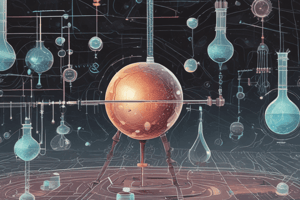Podcast
Questions and Answers
According to the gas laws, which statement about Boyle's Law is correct?
According to the gas laws, which statement about Boyle's Law is correct?
- Volume is directly proportional with Pressure at constant number of moles and Temperature.
- Volume is directly proportional with Temperature at constant number of moles and Pressure.
- Volume is inversely proportional with Pressure at constant number of moles and Temperature. (correct)
- Volume is directly proportional with number of moles at constant Temperature and Pressure.
What happens to the volume of a gas according to Charles's Law?
What happens to the volume of a gas according to Charles's Law?
- It remains constant with changing temperature at constant number of moles and pressure.
- It increases with increasing temperature at constant number of moles and pressure. (correct)
- It increases with decreasing temperature at constant number of moles and pressure.
- It decreases with increasing temperature at constant number of moles and pressure.
Which factor affects the gas behavior according to the ideal gas law?
Which factor affects the gas behavior according to the ideal gas law?
- Number of moles
- Temperature (correct)
- Pressure
- Volume
What is the value of the ideal gas constant (R) in the ideal gas law?
What is the value of the ideal gas constant (R) in the ideal gas law?
Why do gases take the shape and volume of their container according to the General Chemistry lecture?
Why do gases take the shape and volume of their container according to the General Chemistry lecture?
Study Notes
Boyle's Law
- Boyle's Law states that the pressure of a gas is inversely proportional to its volume when temperature remains constant.
- If pressure increases, volume decreases, and vice versa, illustrating the relationship between these two properties of gases.
Charles's Law
- According to Charles's Law, the volume of a gas is directly proportional to its absolute temperature when pressure is held constant.
- If temperature increases, the volume of the gas also increases, and if temperature decreases, the volume decreases.
Ideal Gas Law Factors
- The Ideal Gas Law relates pressure (P), volume (V), temperature (T), and the number of moles (n) of an ideal gas in the equation PV = nRT.
- Factors affecting gas behavior include pressure, volume, temperature, and the number of gas molecules.
Ideal Gas Constant (R)
- The value of the ideal gas constant (R) is approximately 0.0821 L·atm/(K·mol) or 8.314 J/(K·mol), depending on units used in calculations.
Behavior of Gases in Containers
- Gases take the shape and volume of their containers due to their particles being in constant, random motion and having much lower density compared to liquids and solids.
- There are minimal intermolecular forces in gases, allowing them to expand and fill available space completely.
Studying That Suits You
Use AI to generate personalized quizzes and flashcards to suit your learning preferences.
Description
Test your knowledge of the state of matter and gas laws, including the characteristics of solids, liquids, and gases. Explore the factors influencing each state of matter and their behavior under different conditions.




